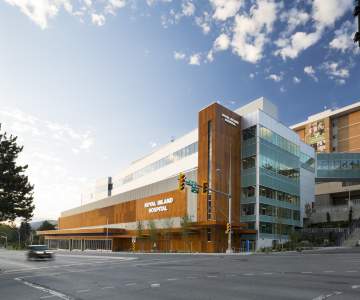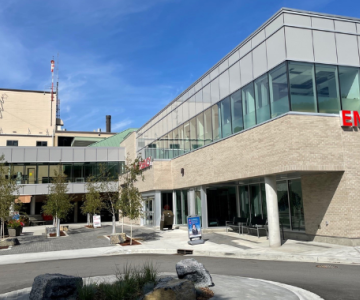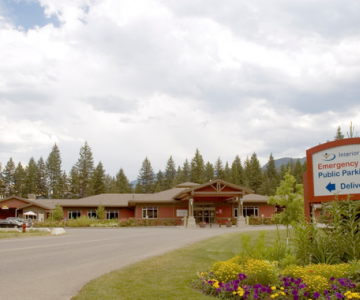July 21, 2022
News Release
Summer is here and, for many of us in the B.C. Interior, it’s a time to enjoy actively moving around in our communities. Many people are enjoying alternative low carbon ways of getting around. E-scooters are a convenient, fun alternative to driving a car.
Two Interior communities – Kelowna and Vernon – are currently participating in a three-year provincial pilot project, allowing residents and visitors to use electric kick scooters (e-scooters) under similar rules as bikes and e-bikes. In addition, many individuals across the region have access to their own e-scooter.
As this newer form of transportation is sharing the road with other modes, Interior Health is committed to working with all partners to ensure injury prevention remains a top priority. Evidence from 2021 suggests an increase in the number of scooter-related injuries as compared to the previous five years. The most affected age groups were young individuals between the ages of 20 and 40, and the most common types of injuries were fracture of the upper extremities and open wounds to the head and neck. More than 90 per cent of individuals injured did not wear a helmet at the time of injury.
“Road safety is everyone’s business,” said Dr. Silvina Mema, medical health officer, Interior Health. “It’s important that everyone plays their part to prevent transportation-related injuries and associated impacts experienced in our communities. There are significant health-care costs as well and personal impacts for people who experience serious injuries.”
Interior Health is reminding anyone who uses a privately owned or shared e-scooter to keep safety top of mind and follow the e-scooter provider specifications. Here are a number of steps you can take to ride safely and reduce the risk of injury to yourself or others:
Wear a helmet
Don’t carry passengers (e.g., doubling)
Never ride under the influence of drugs or alcohol
If you are a less experienced rider, start slow and in areas of low traffic
Ride at a safe speed and in designated areas such as protected lanes and quiet streets
Remember you must be 16 or older to ride an e-scooter in B.C. (Kelowna-based operators currently require you to be 18 or older)
Know the rules - familiarize yourself with where you can and cannot ride
Ensure your e-scooter is equipped with a braking system and added safety features, including a bell, lights and reflectors
These tips also apply to other types of active travel, such as cycling, skateboarding, non-electric scooters and roller skating/blading.
Interior Health supports alternative modes of transportation and will continue to partner with communities to monitor health-related impacts.
Information on the shared e-scooter programs operating within Interior Health, including their safe use and designated areas for riding, are available on the City of Kelowna, City of Vernon and the Ministry of Transportation and Infrastructure's websites.
July 15, 2022
Public Service Announcement
People who use Royal Inland Hospital (RIH) are advised of changes to the way they access the Kamloops hospital, beginning Monday, July 18 with the opening of the Phil & Jennie Gaglardi Tower.
The public will now access the main entrance and the emergency department in a new way.
Main entrance and patient drop off
The new main entrance and patient drop-off area is located at the front doors of the Gaglardi Tower, across from the Clinical Services Building (CSB) parkade. Public parking remains in the CSB parkade and people can walk from Level P4 of the CSB parkade and follow the sidewalk to access the main entrance to RIH.
Emergency entrance
The new, permanent emergency entrance at RIH is located at the roundabout (near the old coffee shop). There is no longer any emergency parking near the ambulance bay. Short-term public parking for the emergency department is now located on the right side of the drive leading to the roundabout. Signage will be in place to help guide patients.
View parking map
July 11, 2022
Public Service Announcement
TRAIL – People who rely on Kootenay Boundary Regional Hospital (KBRH) in Trail are advised that the main and emergency department public entrances will be closed for three weeks beginning July 11.
Construction crews will be working on enhancing the entrance access to the regional hospital.
To allow for the construction, patients and visitors will be directed to the ambulance bay entrance at KBRH.
The bus stop will be temporarily relocated closer to the interim entrance and greeters will be in specific locations to help assist people accessing the hospital. Signage will also be in place.
Interior Health regrets any inconvenience to people while this work is taking place.
July 8, 2022
News Release
A new pharmacy at Kootenay Boundary Regional Hospital is now open, offering enhanced operational efficiency, improved working conditions and modern technology.
Read the full release
July 7, 2022
Public Service Announcement
CLEARWATER - Clearwater and area residents are advised of a temporary change to the emergency department hours at Dr. Helmcken Memorial Hospital tonight due to limited staffing availability.
The emergency department will be closed:
6 p.m. Thursday, July 7 to 7 a.m. Friday, July 8
Full service will resume on Friday, July 8 at 7 a.m.
Interior Health regrets this temporary change to normal operations and reminds residents to take note of the following if they require care while the emergency department is closed:
In the event of an emergency, call 911.
Visit the emergency department at one of the following facilities:
Royal Inland Hospital – 311 Columbia Street, Kamloops
Call HealthLink BC at 8-1-1 (24 hour service) if you are unsure of your need to seek emergency care.
The emergency department in Clearwater is normally open 24/7.
July 3, 2022
Public Service Announcement
MERRITT – Merritt and area residents are advised that the emergency department at Nicola Valley Hospital will be closed 8 a.m. July 4 until 8 a.m. July 5, due to limited physician availability.
Interior Health regrets this temporary change to normal operations and reminds residents to take note of the following if they require care while the emergency department is closed:
In the event of an emergency, call 911.
Visit the emergency department at one of the following facilities:
Royal Inland Hospital – 311 Columbia Street, Kamloops
Kelowna General Hospital – 2268 Pandosy Street, Kelowna
Call HealthLink BC at 8-1-1 (24 hour service) if you are unsure of your need to seek emergency care.
Interior Health apologizes for this temporary interruption to normal services.
July 2, 2022
Public Service Announcement
Clearwater and area residents are advised of a temporary change to the emergency department hours at Dr. Helmcken Memorial Hospital due to limited staffing availability.
The emergency department will be closed:
8 a.m. Saturday, July 2 to 8 a.m. Sunday, July 3
Full service will resume on Sunday, July 3 at 8 a.m.
Interior Health regrets this temporary change to normal operations and reminds residents to take note of the following if they require care while the emergency department is closed:
In the event of an emergency, call 911.
Visit the emergency department at one of the following facilities:
Royal Inland Hospital – 311 Columbia Street, Kamloops
100 Mile House General Hospital – 555 Cedar Ave South
Call HealthLink BC at 8-1-1 (24 hour service) if you are unsure of your need to seek emergency care.
The emergency department in Clearwater is normally open 24/7.
June 29, 2022
Public Service Announcement
Clearwater and area residents are advised of a temporary change to the emergency department hours at Dr. Helmcken Memorial Hospital tonight due to limited staffing availability.
The emergency department will be closed:
6 a.m. to 7 p.m. Thursday, June 30
Full service will resume on Thursday, June 30 at 7 p.m.
Interior Health regrets this temporary change to normal operations and reminds residents to take note of the following if they require care while the emergency department is closed:
In the event of an emergency, call 911.
Visit the emergency department at one of the following facilities:
Royal Inland Hospital – 311 Columbia Street, Kamloops
Call HealthLink BC at 8-1-1 (24 hour service) if you are unsure of your need to seek emergency care.
The emergency department in Clearwater is normally open 24/7.
June 24, 2022
Information Bulletin
Environment and Climate Change Canada has issued special weather statements for several parts of the province, with daytime temperatures in the Interior ranging from the low to mid 30s. This is not a heat warning or an extreme heat emergency, but we will experience the first high temperatures of the summer. The warmer weather will also cause rapid snow melt, leading to high rivers and streams throughout the province so please keep water safety in mind this weekend.
The first high temperatures of the season can lead to some people overheating because they are not yet acclimatized to warmer weather. There are some basic steps you can take to ensure you and your family remain safe and healthy during warmer temperatures.
Additional heat information is available on the Interior Health public website. The BC Centre of Disease Control (BCCDC) also has a broad range of heat-related information on its website, including information on the different types of heat alerts, how to prepare for warmer temperatures, symptoms of heat-related illnesses, those most at risk during warmer weather, and ways to stay cool.
Preparing for hot weather:
Identify a cooler space in your home and prepare it so you can stay there at night, if possible. You may need to change daily living arrangements.
Find an air-conditioned spot close by where you can cool off on very hot days. Consider staying with friends or family or find places in your community to spend time such as movie theatres, libraries, community centres, or shopping malls.
Check that you have a working fan. If you have an air conditioner, make sure it works.
Install awnings, shutters, blinds, or curtains over your windows to keep the sun out during the day.
Practice opening doors and windows to move cool air in at night and shutting windows during the day to prevent hot outdoor air from coming inside.
Get a digital room thermometer to keep with you so you know when your home is getting too hot.
Who is most at risk?
It is important to monitor yourself and family members, and to consider developing a check-in system for neighbours and friends who are at higher-risk during warmer weather
The most susceptible individuals include:
Older adults, especially those over 60
people who live alone
people with pre-existing health conditions such as diabetes, heart disease or respiratory disease
people with mental illnesses such as schizophrenia, depression, or anxiety
people with substance use disorders
people with limited mobility
people who are marginally housed
people who work in hot environments
people who are pregnant
infants and young children
Your health:
Spray your body down with water, wear a damp shirt, take a cool shower or bath, or sit with part of your body in water to cool down if you are feeling too hot.
Drink plenty of water and other liquids to stay hydrated, even if you are not feeling thirsty
Take it easy, especially during the hottest hours of the day.
Stay in the shade and use a broad spectrum sunscreen with SPF 30 or more.
Signs of overheating include feeling unwell, headache, and dizziness. Take immediate action to cool down if you are overheating.
It is important to remember that overheating can lead to heat exhaustion and heat stroke.
Signs of heat exhaustion include heavy sweating, severe headache, muscle cramps, extreme thirst, and dark urine. If you are experiencing these symptoms, you should seek a cooler environment, drink plenty of water, rest, and use water to cool your body.
Heat stroke is a medical emergency
In the event of a medical emergency, British Columbians are advised to call 9-1-1. However, it is also important to use 9-1-1 responsibly to avoid overwhelming the system.
BC Emergency Health Services in partnership with ECOMM is reminding British Columbians to only dial 9-1-1 for serious or life-threatening injuries
When to call 9-1-1:
In general: when there is chest pain, difficulty breathing, loss of consciousness, severe burns, choking, convulsions that are not stopping, a drowning, a severe allergic reaction, a head injury, signs of a stroke, a major trauma.
More specifically related to hot weather: severe headache, confusion, unsteadiness, loss of thirst, nausea/vomiting, and dark urine or no urine are signs of dangerous heat-related illness.
If you have a less urgent health issue:
You can call 8-1-1 and get connected with a nurse at HealthLinkBC. Or, if you can do it safely, you could go to an urgent care centre or clinic.
That way, our highly trained emergency medical dispatch staff and paramedics will be available for people who need their services the most.
There are also online tools at healthlinkbc.ca including a “Check Your Symptoms” tool.
While this bulletin is about the beginning of hot summer weather, additional information on preparing for extreme heat events can also be found in BC’s Extreme Heat Preparedness Guide.
-
Load More
Showing 558 of 953




